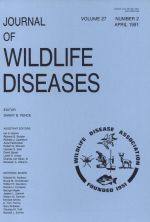Approximately 200 Canada geese (Branta canadensis) died at a playa lake in the Texas Panhandle shortly after a winter wheat field in the basin adjacent to the lake was treated with parathion to control newly invading Russian wheat aphids (Diuraphis noxia). No evidence of infectious disease was diagnosed during necropsies of geese. Brain ChE activities were depressed up to 77% below normal. Parathion residues in GI tract contents of geese ranged from 4 to 34 ppm. Based on this evidence, parathion was responsible for the goose mortalities. Parathion applications to winter wheat will undoubtedly increase if parathion is applied for control of both Russian wheat aphids and greenbugs (Schizaphis graminum). Geese may potentially be exposed to widespread applications of parathion from fall to spring, essentially their entire wintering period.
How to translate text using browser tools
1 April 1991
POISONING OF CANADA GEESE IN TEXAS BY PARATHION SPRAYED FOR CONTROL OF RUSSIAN WHEAT APHID
Edward L. Flickinger,
Gary Juenger,
Thomas J. Roffe,
Milton R. Smith,
Roy J. Irwin

Journal of Wildlife Diseases
Vol. 27 • No. 2
April 1991
Vol. 27 • No. 2
April 1991
anticholinesterase poisoning
brain cholinesterase activity
Branta canadensis
Canada geese
mortality
organophosphorus insecticide
parathion




